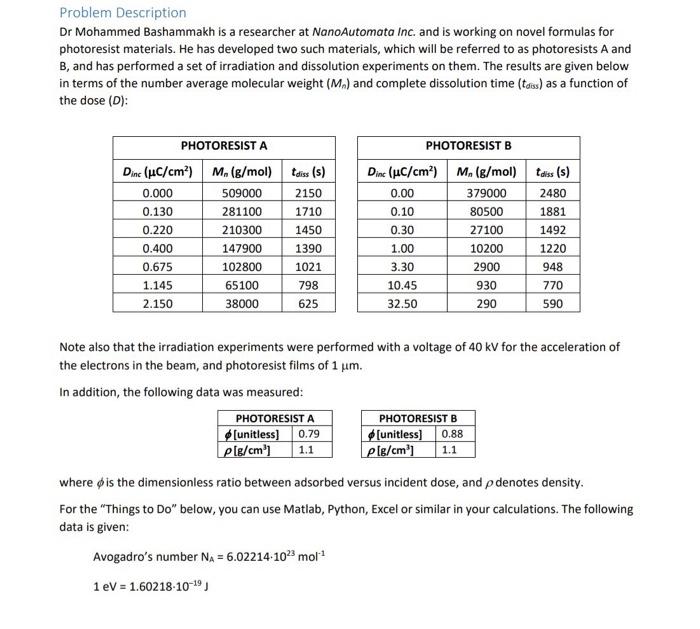Problem Description Dr Mohammed Bashammakh is a researcher at NanoAutomata Inc. and is working on novel formulas for photoresist materials. He has developed two such materials, which will be referred to as photoresists A and B, and has performed a set of irradiation and dissolution experiments on them. The results are given below in terms of the number average molecular weight (Mn) and complete dissolution time (torss) as a function of the dose (D) : Note also that the irradiation experiments were performed with a voltage of 40kV for the acceleration of the electrons in the beam, and photoresist films of 1m. In addition, the following data was measured: where is the dimensionless ratio between adsorbed versus incident dose, and denotes density. For the "Things to Do" below, you can use Matlab, Python, Excel or similar in your calculations. The following data is given: Avogadro's number NA=6.022141023mol1 1eV=1.602181019J 4) The irradiation experiments can be modelled by the following equation: Mn1=Mn01+100NAGD where Mn0 is the initial number average molecular weight (before irradiation), D the dose, NA Avogadro's number, and G the radiation chemical yield. Use linear regression to calculate the radiation chemical yield, G, for each of the two photoresists. Compare the energy efficiency of a microlithography application that uses photoresist A, versus one that uses photoresist B. [10 marks] 5) The dissolution experiments can be modelled by the following equation: dtds=Mn where s denotes the film thickness, t the time, and are constants, and Mn is the number average molecular weight after irradiation. Solve the differential equation for the conditions of the experiment and perform regression to find constants and . Report the values of the constants and their units. [14 marks] 6) Calculate and plot the thickness remaining for the two photoresists in the same axes. Use units of m for the thickness remaining and C/cm2 for the dose, and semilog axes for the plot (logarithmic for the dose, linear for the thickness remaining). [20 marks] 7) From the above plot find the sensitivity and the contrast of each of the photoresists (you can do this graphically or computationally). Based on these results, which of the two photoresists would you choose for a microlithography application any why? Explain you reasoning in detail. [10 marks]








